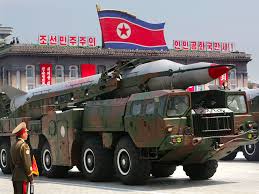North Korean Atomic Weapons Program

December 5, 2016
The international standoff of each nation’s nuclear arsenal increases with the emergence of every warhead enriched with Uranium, maintaining the power for terminal annihilation.
North Korea, a former subsidiary of the Soviet Union, inherited its fixation on Weapons of Mass Destruction as a medium to signify the absolute destruction their leader may yield against foreign adversaries.
In 2006, the DPRK tested its first warhead inside a foreign underground bunker equivalent to a one-kiloton blast; albeit on the lesser side of the nuclear weapon yield spectrum, it still produces the force of one kilotons of TNT. Before this unnatural seismic quake, the United States operated on the assumption that North Korea did not have access to enriched Uranium 238, similar to the conditions with the international sanctions against Pakistan, preventing the formation of atomic weapons research due to the limitation of resources.
Consecutive minor nuclear tremors confirmed the rumors of nuclear-controlled research sparking the International Atomic Energy Agency to describe North Korea as a “fully fledged nuclear power”. Ironically, in the weeks following the recognition of the nuclear threat, the DPRK conducted its second significant thermonuclear test erupting–a shock wave comparable to 2 to 7 kilotons of TNT–in the Northeast province of Mantapsan.
Until recently, the North was restrained by its limited propulsion technology having intercontinental ballistic missiles unable to reach beyond the eastern coast of Japan. This range has been extended to a lengthier 4000 kilometers by the Hwasong-10, which is still unable to arrive at the western shore of the United States and eastern borders of China.
The DPRK revoked its adherence to the Treaty on the Nonproliferation of Nuclear Weapons in 2003, being the only global state to withdraw its signature since its enactment in 1968. In summary, the treaty was a global agreement to research the energy aspect of nuclear power allowing for a peaceful exchange of research by scientists, furthering the effectiveness of nuclear systems, and restricting the further development of WMDs (weapons of mass destruction).
Most recently, North Korea claims that, on January 6th, 2016, their first test with a hydrogen bomb was successful. International geological surveys rejected this claim by stating that the magnitude of a 5.1 seismic disturbance was too minimal to be produced by a hydrogen-fueled weapon. Undisturbed by the evidence disputing their assertions, the DPRK launched a satellite into orbit, which passed over the air space of Japan and was threatened to be shot down by the Japanese prime minister. Calling Japan’s bluff, the North continued with the launch without Japan’s interruption due to the claims that the satellite was purely for peaceful scientific purposes. The intercontinental ballistic missile reached beyond the brink of orbit displaying the enhanced capabilities of North Korea’s IBM’s.
Finally, on September 9th, 2016, the most recent test occurred to produce a twelve kilotons yield, twelve times the magnitude of the first destruction that took place ten years earlier, resulting in the United Nations Security Council increasing the international sanctions against the socialist regime.
The doomsday clock (created by The Society of Atomic Scientists) comes closest to midnight with every newly armed warhead, and the recent threat we face is comparable to the peak of the hostile conditions of the Cold War. There are three minutes left on the clock, and a decision needs to be made for the future of human existence. Before it is too late, the clock strikes midnight.

